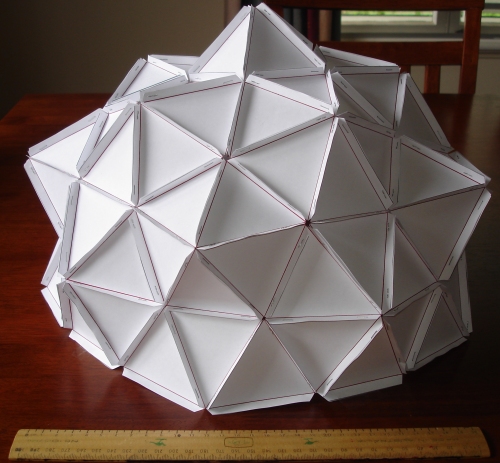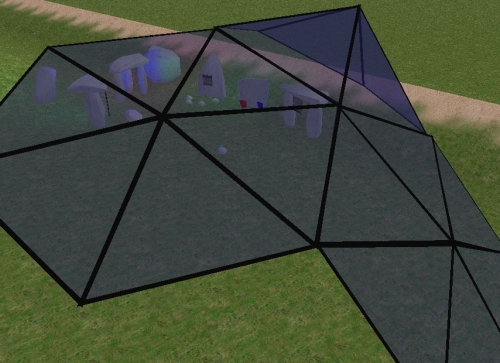Dome a dozen
… so, I imagine ‘Offworld Homebase’ to be a cluster of geodesic domes in a desolate crater [anyone who has seen the Dr Who episode “Water of Mars” will get the idea] – the problem is I do not know how to make a geodesic dome. To the CDROM in the sky called the interweb, researching geometry I realised [or rather decided] that if you were travelling to a far away place with the components to make something, the last thing you would want is a “jigsaw from hell” [that is, hundreds of pieces, each different] so decided to explore making things out of ONE size and shaped triangle.
Originally, I tried equilateral [maths nerd fact: all 3 sides the same length] triangles and when I put them together into a hexagon, it was flat [to make the side curved it needs to be slightly less-so]. So I took a SQUARE, bisected one of the sides, joined that point to opposite corners and voila I had an ISOSCELES triangle [math nerd fact – 2 adjacent sides the same length, both slightly longer than the original side of a square which forms the base, and a means to connect them to others].
Clumping these together into groups of 3, 5 and 6, we now have the basic building blocks of a dome. Now, purists will argue that the triangles used for the pentagonal pyramid should have shorter sides so it sticks up less, but I figure the last thing spacemen want to do on the planets surface is work out whether they need a long or a short triangle … imagine being half up and realising you screwed up one further down.
…so, 6 pentagons, 10 hexagons and 5 half-hexagons later [105 triangles, cut, folded and stapled] we have a dome:
…structurally, and to my great surprise, this paper structure [I designed a ’tiled’ template in an attempt to waste as little paper as possible using CorelDraw and printed it out on normal printer paper] is quite strong. So long as the base is secured on a couple of points, the whole structure stands up on its own and seems to self-organise. In retrospect, I should have had the seams on the inside, but again, I imagined some poor bastard in a space suit with a spanner bolting these panels together.
Making the physical model actually helped me “see” this structure virtually. The interplay of sides, angles and so on was instructive [if a little madenning towards the end, was a little “craft project from hell” as each layer of new facets caused the structure alternately rigid then floppy]. making the virtual model was another issue alltogether. I remember, in the object yard, seeing a square-based triangular panel, so went and got the name of that object, next to rockshop I created a triangle, duplicated it, rotated it 60°, rinsed and repeated 4 more times to make a neat hexagon, then inclined each facet of the hexagon until the seams aligned and neatly met at a point. Saving that as an “object group” [so I can spawn more of them in one step later], I did the same for a pentagon [72° rotation this time].
The most difficult part of the 3D build was angling the panels so they seamlessly joined – pitch, yaw and rotation is really difficult to gauge from only ONE perspective point and I have yet to find a way to move without having to de-select the object I am working on [Activeworlds object manipulation keys are the same keys you use to move, in a different context] … am sure there is an efficient way of doing this [certainly in SecondLife the camera re-positioning is superior to anything I have found so far in AW], yet to determine if there is an angle recipe I can use [which would make the tilting simpler and less “guesswork”].
What did I learn? I know a little more about engineering [enough to realise as an Engineer, I make an adequate teacher 😛 ], and there is a definite construction order if you were to actually try to build one of these things with any force of gravity acting on you. I also learend that the modular approach is what would be used if you had to ransport everythign tot he remote location, and the SIMPLER the better in terms of modules, if you think about them, other structures are possible with the same shaped buts [tunnels, turrets, tubes and so on. Triangles are strong, the weakest part of any structure are the joints.
Scale is difficult to determine – if I continue as I am with the structure in-world, the dome will be MILES high and that is a little silly, so will return to the CDROM in the sky to see if there is a way of determining scale of the structure, as it must be some proportion of the side length [yeah, I know, my engineering friends will be saying “duh”]. The other model I need to explore is the “soccer ball” model, that uses alternated FLAT hexagons and pentagons – less pieces, smoother shape I suspect … all very interesting.
Tags: activeworld, build, dome, geodesic, structure



Wonko
In Second Life there are scripts that build these domes and many other structures automatically. Can you script the world to build them for you?
Lindy
possibly a building bot, will explore that possibility
This is a good blog, I was wondering if I could use this piece on my website, I will link it back to your website though. If this is a problem please let me know and I will take it down right away.
happy to have you link, glad _someone_ finds this stuff interesting